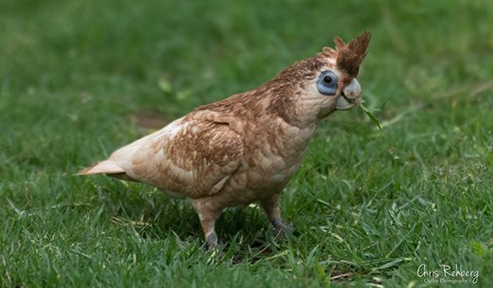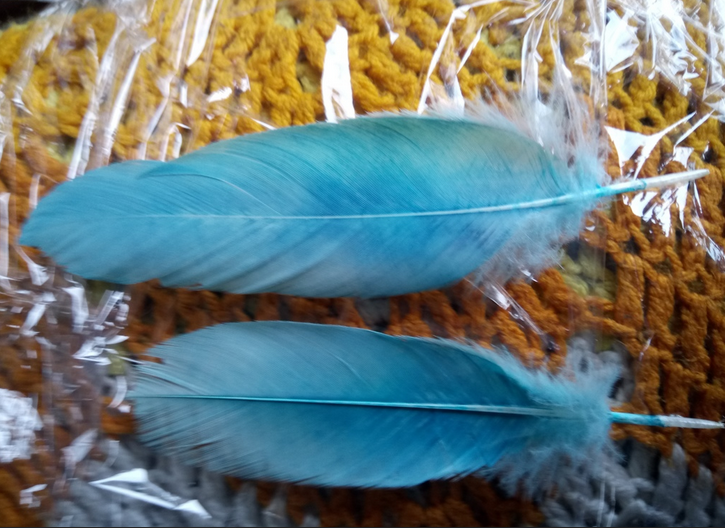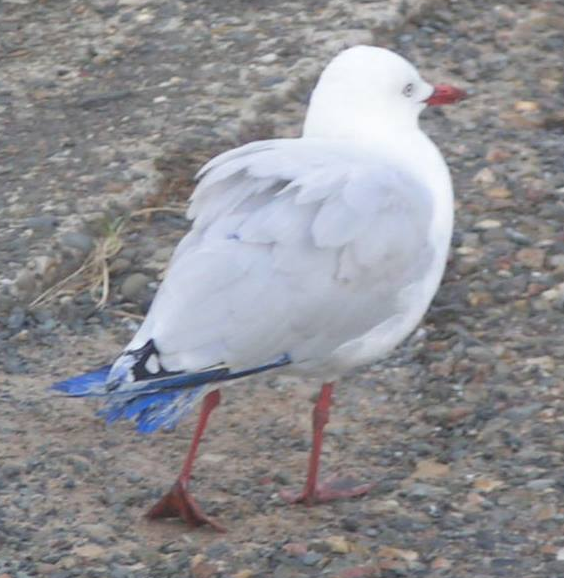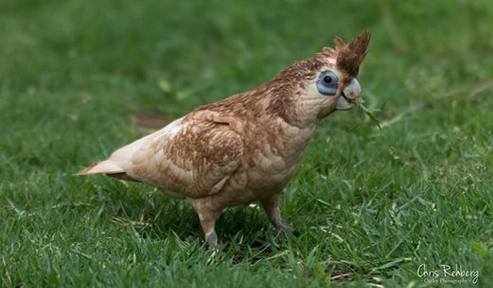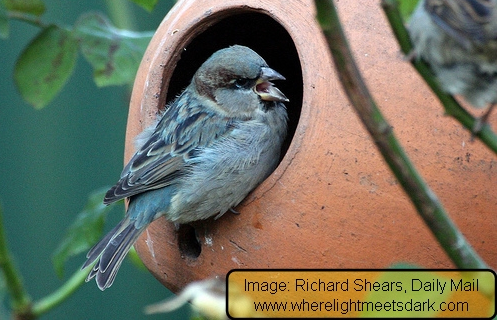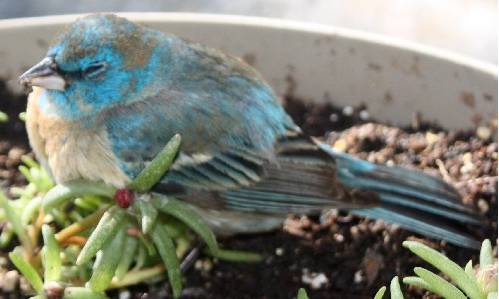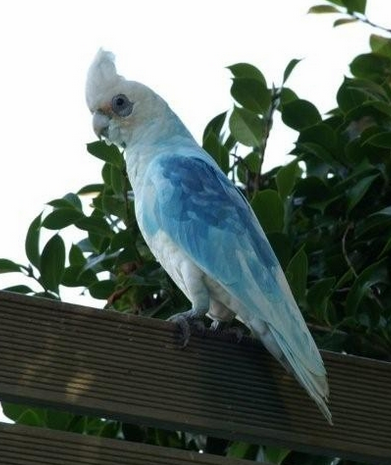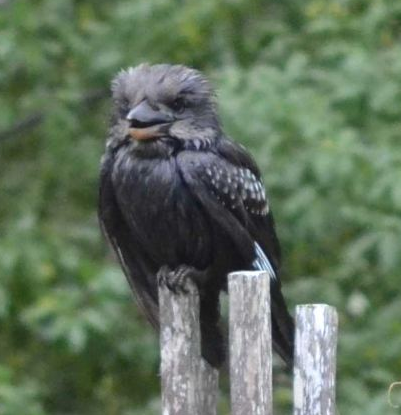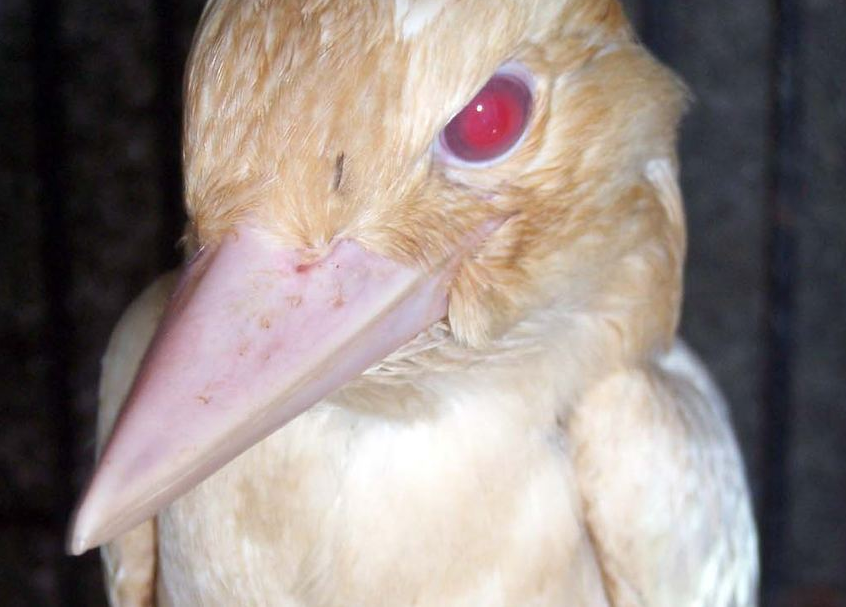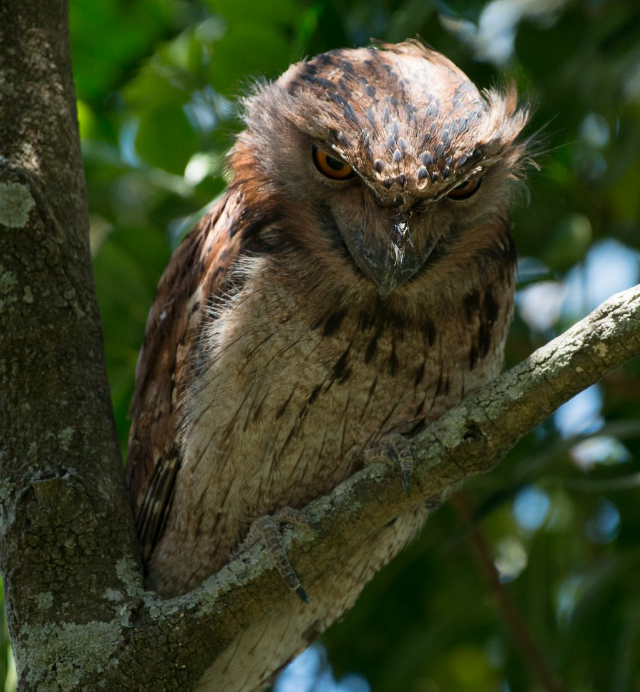Unusually coloured birds
Have you seen an unusually coloured bird?
- Send your bird photo or report here - please include location, date, and whether you're happy to have the photo added here.
Little Corella stained brown.
Overview
Birds of unusual colouration appear regularly in mainstream media and amongst interest groups on social media. This page discusses a few accounts in detail, presents reader-contributed photographs and examples, and offers some explanations for how birds might how unusual colouration.
Causes of unusual colouration in birds
The causes of unusual colouration in birds are varied and include:
- morphs - natural colour variations that may not be common)
- melanism - higher than usual production of dark pigment
- leucism - a lower than usual production of dark pigment (sometimes partial, affecting only parts of the body)
- albinism - a lack of dark pigment, often identifiable by the animal having red pupils in its eyes.
- illness - one often cited example being Psittacine Beak and Feather Disease (PBFD) which can lead to a brown colouration in feathers
- artificial pigments - such as from dyes, which may be used to colour water that has been chemically treated with pesticide, for example
- charcoal - from burnt timber and trees, for example, after bushfire
- fungus - from the body rubbing against fungus that might grow in tree hollows
- wood pulp - especially after wet weather, and especially when a bird such as an Australian parrot is sculpting the interior of a tree hollow
- bio-luminescence - although uncommon, some have speculated that birds may come into contact with bio-luminescent fungus or that the Barn Owl might even exhibit its own bio-luminescence.
- hybrid breeding - when two different species produce young, the young may exhibit colouration that is not an exact match for either of the parent species.
- domestication - when birds are selectively bred over large time scales, the resulting breeds and races may vary enormously from the original species source stock.
- diet - Canaries, in particular, are known for an orange form - rather than the "usual" yellow - that is diet induced.
- misidentification - some have sent through photos of the Blue Bunting, which really is a blue bird, believing it was an unusually coloured sparrow.
Did you know?
There is no such thing as a blue bird. More correctly, no bird is able to produce a blue pigment. When we see a bird that looks blue (as its natural colour - not like the stained birds here), what is happening is that the structure of its proteins is splitting light into different wavelengths, and blue reflects off the bird - but not in the same way that a blue pigment appears blue.
Introduction
In April 2009 Richard Shears, a journalist with the Daily Mail (UK) published photographs of a blue House Sparrow (Passer domesticus) which visited his garden in Sydney, Australia. In July a reader of Where Light Meets Dark made contact - quite unaware of the blue sparrow - to enquire about blue Little Corellas (Cacatua sanguinea) photographed by his friend on the Central Coast just north of Sydney, NSW.
Whilst investigating these two incidents, information came to light about a third species of bird seen with blue plumage - the Australian White Ibis (Threskiornis molucca). Finally, in June 2010 another reader sent through photos of another blue sparrow - this time from Canada. In all these cases it seems as if the colouration has been caused by a blue dye. Some explanations for blue-coloured dyes include that it is used with crop spraying insecticides and in shipyards with anti-fouling paint.
From the time of this early investigation, many readers of WLMD have submitted photographs of variously coloured birds. Various birds appear in social media groups and occasionally in mainstream media. I have also found photographs of a Silver Gull with blue staining in my own collection and taken photographs of an Australian Magpie exhibiting leucism.
Critical analyses
| Date | Name | Type | Location | Notes | ||
|---|---|---|---|---|---|---|
| 2010 | Blue Bunting | Photos | Canada (outside Australia) | 1 bird photographed | ||
| 2009 | House Sparrow | Photos | Sydney, NSW | 1 bird photographed; possible sighting of 2nd bird | ||
| 2008, 2009 | Little Corellas | Photos | Central Coast, NSW | Numerous birds photographed on numerous occassions; also 1 brown bird | ||
| 2008 | Australian White Ibis | Photos | Sydney, NSW | Three sightings between June and November 2008. Photographed twice. Probably 1 bird, with blue feathers being replaced by white ones during moult |
Conclusion
In the pages above you'll read of various theories, including genetic mutations, cross-breeding, diet and dye.
Wildlife Management Officer Geoff Ross, with the Parks & Wildlife Group - Department of Environment and Climate Change (PWG/DECC) has this to say about the blue ibis in particular:
"We monitored this bird for a while around Sydney (it hasn't been seen for some time now). In the past we've seen others with dye on the feathers. There are sites in or around Sydney , where somehow these birds come into contact with a dye. Most have been waterbirds, Pelican, Ibis etc. I think the dyes are water soluble because they seem to fade after rain. Usually when the dyed birds show up there's a lot of discussion to find out if anyone is using dye tags, in this case no one knew of any dye tagging programs. Ibis particularly are commonly found at waste centres, tips and other refuse areas and are often exposed to a variety of human refuse. The colouration does not appear to affect their condition, they seem to be able to feed and carry on as usual." (personal communication, 14/7/09)
One more point to note is that although the ibis was commonly seen in large aggregations of ibis, none of the other birds was blue. This tends to favour the theory that the colouration is due to immersion in a dye, rather than ingestion. Likewise the blue sparrow was seen in a normally coloured flock. Although the blue corellas appeared in a flock, the colouration varied significantly from bird to bird and in the case of the last blue corella on that page, appears to have been splattered on the bird.
Regarding the brown corella on the same page, Ross says "I have seen Corella, and Sulphur-crested cockatoos in Sydney suffering from a disease called Psittacine circoviral Disease or "Psittacine Beak & Feather". The brown discolouration on the feathers appears to be a very early symptom of the disease."
Reader contributions - photo gallery
Many readers have sent through sightings and photographs of many bird species in various different colours. Some of these are reproduced here, with permission.
Sulphur-crested Cockatoo (Cacatua galerita), Russell Island, Qld, AU, 2017. This bird has probably been stained by charcoal - note the face is white, the neck is heavily stained, and the belly is stained also. This pattern matches behaviour where the bird might be reaching into a tree hollow to feed chicks or to sculpt the inside of the hollow - the neck repeatedly rubs the edge of the hollow (which is presumably burnt) and the body rubs burnt areas of wood also. Melanism might be an alternative cause. Photo: Julie Forrest. | Feathers of Little Corella (Cacatua sanguinea), Kings Langley, Sydney, NSW, AU, 2018. These feathers are almost certainly stained and the colour is not via growth - as can be seen by the naturally coloured root of each quill. Photo: Kathy Byers. |
Sulphur-crested Cockatoo (Cacatua galerita), Ermington, Sydney, NSW, AU, 2017. This slight brown staining is likely due to wood pulp from a tree hollow. The reader reported some slight pink staining, although I cannot see it here, and noted other birds regularly had strong pink staining. Photo: George Emeleus. | Silver Gull (Chroicocephalus novaehollandiae), Port Macquarie, NSW, AU, 2006. This bird has had the tips of its wings and tail dyed with blue. Although it may have been dyed as part of a research program, discussions online suggest it might have come into contact with anti-fouling paint at a shipyard. Photo: Chris Rehberg. |
Blue Bunting (Cyanocompsa parellina), Chicago, Illinois, USA, 2018. This bird was submitted by a reader who suspected it to be a sparrow - but I believe it is a Blue Bunting, which is a bird that is naturally blue. The "unusual colouration" here is due to a misidentification of species. (Bird was found deceased on the road). Photo: Mike Brown. | Little Corella (Cacatua sanguinea), Peakhurst, Sydney, NSW, AU, 2018. An example of a heavily stained bird. The brown colour is likely due to wet wood pulp from a tree hollow that the bird was excavating or sculpting. Photo: Chris Rehberg. |
House Sparrow (Passer domesticus), Sydney, NSW, AU, 2009. This House Sparrow, apparently stained blue, appeared in local media in 2009. | Little Corella (Cacatua sanguinea) x Galah (Eolophus roseicapilla) Hybrid, location unknown, AU, 2008. This bird looks a little like a Little Corella (which is almost entirely white) and a Galah (which is a stronger pink-grey combination) but not fully either. The reason is that it is a hybrid between the two species. Its resulting colouration, in this case, is a blend of the two parent birds. Photo: Mike. Source: Birds in Backyards forum. |
Australian White Ibis (Threskiornis molucca), Chullora, Sydney, NSW, AU, 2008. A reader contacted me to say that he saw a photograph published in June 2008, of a blue Australian White Ibis - which he subsequently located at Freshwater Creek Wetlands, Chullora. In November he again saw a blue ibis here and believes it is probably the same bird, although some of the blue feathers appeared to have molted and been replaced with white ones. This supports the view that blue in birds like this is due to some permanent stain. He also reported collecting a blue feather, but I am unsure what happened to that specimen. Photo: Reader-supplied. | Blue Bunting (Cyanocompsa parellina), Saskatchewan, Canada, circa 2009. This bird had suffered impact with a window and was stunned for some 3 hours before flying off. Although originally reported here on WLMD as a sparrow showing blue colouration, readers wrote in to clarify this is in fact a Blue Bunting - a bird which is naturally blue. As with the earlier bunting on this page, the "unusual colouration" is due to misidentification. Photo: Brandine Allen. |
Little Corella (Cacatua sanguinea), Wamuran, Qld, AU, 2018. This bird has probably been sculpting the inside of a tree hollow - perched at the entrance to the hollow with only its head inside. The brown staining comes from rubbing against the wood pulp it is tearing away from the inside of the hollow. This type of staining is probably increased during times of wet weather when the wood pulp might become damp. Photo: Donna Hill. | Australian Magpie (Cracticus tibicen), Picnic Point, Sydney, NSW, AU, 2018. This bird has leucism, which is a reduction in the expression of dark pigment. Australian Magpies are ordinarily a very solid black and white. This is not albinism, however, as the eye still appears to show dark pigmentation; if the bird were albino, the eye would appear red. Photo: Chris Rehberg. |
Sulphur-crested Cockatoo (Cacatua galerita), Peakhurst, Sydney, NSW, AU, 2018. Sulphur-crested Cockatoos and Little Corellas seem often stained brown. As with the other birds on this page, this one has likely been stained by damp wood pulp while excavating a tree hollow for nesting. Photo: Chris Rehberg. | Little Corella (Cacatua sanguinea), Central Coast, NSW, AU, 2009. A reader supplied this image, taken by a colleague, along with several other Little Corellas, each stained varying degrees of blue. Some speculate that blue is a colour mutation - in part because the colour appears to be permanent, lasting even through rain. It would seem more likely to be a stain, given multiple birds in the same flock showed blue to varying degrees. That said, the Budgerigar is green and yellow in the wild, but domestic forms exist in blue - implying at least that parrot species (Budgerigar) is capable of producing blue feathers. Photo: Reader-supplied. |
Laughing Kookaburra (Dacelo novaeguineae), Manjimup, WA, AU, 2018. This kookaburra appears much darker than usual as a result of melanism, which is an over-expression of dark pigment - in much the same way that a "black panther" is actually a melanistic leopard, jaguar or cougar. As such, the bird is not stained. It was believed the first in decades to be seen in that state and is certainly a rare occurance for kookaburras. Photo: Mike: Source: ABC News. | Laughing Kookaburra (Dacelo novaeguineae), Qld, AU, date unknown. This kookaburra appears almost all-white, with red pupils in its eyes. This total lack of dark pigment is called albinism, making this an albino Laughing Kookaburra. Photo: AAP. Source: ABC News. |
Masked Lapwing (Vanellus miles), Nudgee, Qld, AU, 2018. This bird exhibits partial leucism, where the expression of dark pigment is suppressed on parts of the body. Albinism would be a total suppression, but as dark (black) pigment is still seen on the head and throad, and in the pupil of the eye, this is not albinism. Photo: Jacqui Edwards. | Tawny Frogmouth (Podargus strigoides), Old Bar, NSW, AU, 2018. Tawny Frogmouths are more commonly seen in a greyish colour. This bird exhibits the rufous morph - "rufous" meaning "reddish/brown" and "morph" meaning a natural colour variation. That is to say, this is a naturally occurring colour form for this species, although this colour appears far less commonly than the usually-seen grey morph. In this species' case, it is only ever females that exhibit the rufous morph. Photo: Chris Rehberg. |
